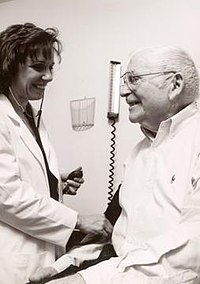
Photo from wikipedia
Importance The US health care system is typically organized around hospitals and specialty care. The value of primary care remains unclear and debated. Objective To determine whether an association exists… Click to show full abstract
Importance The US health care system is typically organized around hospitals and specialty care. The value of primary care remains unclear and debated. Objective To determine whether an association exists between receipt of primary care and high-value services, low-value services, and patient experience. Design, Setting, and Participants This is a nationally representative analysis of noninstitutionalized US adults 18 years or older who participated in the Medical Expenditure Panel Survey. Propensity score–weighted quality and experience of care were compared between 49 286 US adults with and 21 133 adults without primary care from 2012 to 2014. Temporal trends were also analyzed from 2002 to 2014. Exposures Patient-reported receipt of primary care, determined by the 4 “Cs” of primary care: first-contact care that is comprehensive, continuous, and coordinated. Main Outcomes and Measures Thirty-nine clinical quality measures and 7 patient experience measures aggregated into 10 clinical quality composites (6 high-value and 4 low-value services), an overall patient experience rating, and 2 experience composites. Results From 2002 to 2014, the mean annual survey response rate was 58% (range, 49%-65%). Between 2012 and 2014, compared with respondents without primary care (before adjustment), those with primary care were older (50 [95% CI, 50-51] vs 38 [95% CI, 38-39] years old), more often female (55% [95% CI, 54%-55%] vs 42% [95% CI, 41%-43%]), and predominately white individuals (50% [95% CI, 49%-52%] vs 43% [95% CI, 41%-45%]). After propensity score weighting, US adults with or without primary care had the same mean numbers of outpatient (6.7 vs 5.9; difference, 0.8 [95% CI, −0.2 to 1.8]; P = .11), emergency department (0.2 for both; difference, 0.0 [95% CI, −0.1 to 0.0]; P = .17), and inpatient (0.1 for both; difference, 0.0 [95% CI, 0.0-0.0]; P = .92) encounters annually, but those with primary care filled more prescriptions (mean, 14.1 vs 10.7; difference, 3.4 [95% CI, 2.0-4.7]; P < .001) and were more likely to have a routine preventive visit in the past year (mean, 72.2% vs 57.5%; difference, 14.7% [95% CI, 12.3%-17.1%]; P < .001). From 2012 to 2014, Americans with primary care received more high-value care in 4 of 5 composites. For example, 78% of those with primary care received high-value cancer screening compared with 67% without primary care (difference, 10.8% [95% CI, 8.5%-13.0%]; P < .001). Americans with or without primary care received low-value care with similar frequencies on 3 of 4 composites, although Americans with primary care received more low-value antibiotics (59% vs 48%; difference, 11.0% [95% CI, 2.8%-19.3%] P < .001). Respondents with primary care also reported significantly better health care access and experience. For example, physician communication was highly rated for a greater proportion of those with (64%) vs without (54%) primary care (difference, 10.2%; 95% CI, 7.2%-13.1%; P < .001). Differences in quality and experience between Americans with or without primary care were essentially stable between 2002 and 2014. Conclusions and Relevance Receipt of primary care was associated with significantly more high-value care, slightly more low-value care, and better health care experience. Policymakers and health system leaders seeking to improve value should consider increasing investments in primary care.
Journal Title: JAMA Internal Medicine
Year Published: 2019
Link to full text (if available)
Share on Social Media: Sign Up to like & get
recommendations!